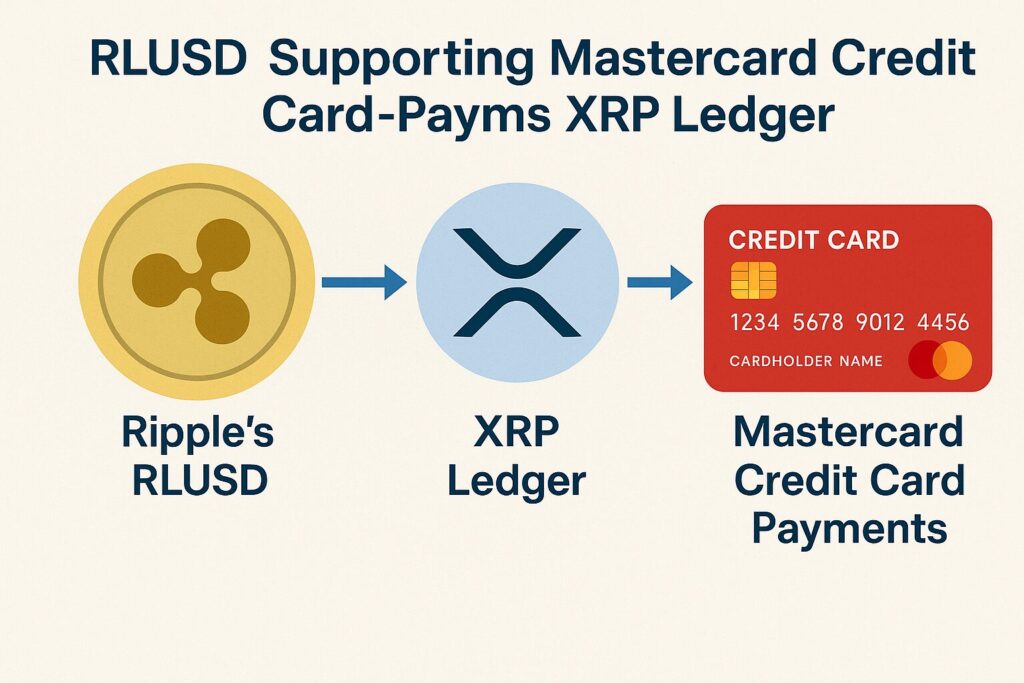
Main Points :
- Ripple is launching a pilot with Mastercard, WebBank and Gemini to use its U.S.-dollar-backed stablecoin RLUSD on the public XRP Ledger (XRPL) for credit-card settlement.
- The initiative could become among the first cases in which a regulated U.S. bank uses a regulated stablecoin on a public blockchain to settle mainstream credit-card transactions.
- RLUSD is issued under a New York trust charter, fully backed by cash and equivalents, with circulation already surpassing US$1 billion.
- The pilot is intended to demonstrate how blockchain infrastructure can bring faster, more efficient settlement behind the scenes of a familiar consumer experience (swipe a card) without disturbing compliance or familiar flows.
- For new crypto assets, income opportunities, and practical blockchain applications, this move signals that regulated stablecoins and public ledgers may increasingly support mainstream finance rather than merely speculative niches.
1. Background: From Speculation to Infrastructure
Over the past decade the crypto industry has largely focused on speculative tokens, decentralised finance experiments, and peer-to-peer payments. However, the gap between traditional finance (TradFi) and blockchain infrastructure has remained wide—banks and card networks process settlements via legacy systems that often span days and involve multiple intermediaries.
With this initiative, Ripple is aiming to close that gap by deploying its RLUSD stablecoin on XRPL for real-world credit-card settlement flows. For practitioners seeking practical blockchain use cases, this marks a meaningful shift: from “crypto for its own sake” to “blockchain enabling existing finance”.
In fact, the pilot announced during Ripple’s “Swell 2025” event positions RLUSD as a compliance-friendly regulated stablecoin, and XRPL as the settlement layer beneath card transactions—rather than a novelty experiment. According to publicly reported articles, the collaboration with Mastercard, WebBank, and Gemini is designed to test whether value can move almost instantly between merchant acquiring banks and card issuers via blockchain settlement, instead of waiting one to three days in the conventional model.
For anyone scouting new crypto assets or payment-rail innovations, the combination of a regulated bank, a major card network, and a public ledger settlement suggest the potential transition of crypto-native rails into mainstream finance.
2. The Players and Their Roles
Ripple: Known for its enterprise-blockchain work and the XRPL, Ripple issued RLUSD in December 2024 under a New York Department of Financial Services (NYDFS) charter. The coin is fully backed by reserves, making it institutionally compliant.
Mastercard: A global payments giant seeking to integrate regulated digital assets and tokenised bank money into its payments ecosystem. It is reported to support this pilot as part of a broader push into blockchain-enabled settlement.
WebBank: A U.S.-chartered bank issuing the Gemini Credit Card. Under the pilot, WebBank will test RLUSD for settling transactions made via that card on XRPL.
Gemini: The crypto exchange which issues the Gemini Credit Card; it will link with WebBank and Ripple’s XRPL rails in this initiative.
Each partner brings a piece of the stack: card network, bank charter, stablecoin/ledger. For those analysing new crypto asset opportunities, such alignment is significant: it means stablecoin and ledger infrastructure are being positioned not as speculative rails but as functional plumbing for regulated finance.
3. How the Pilot Works & What It Tests

What is being tested:
- RLUSD will be onboarded to XRPL in the coming months (pending regulatory approvals).
- WebBank (issuer of Gemini Credit Card) will use RLUSD to settle transactions made via Mastercard, using XRPL as the settlement layer.
- The consumer experience remains unchanged—card swipe, merchant payment—while backend infrastructure shifts to blockchain. Monica Long of Ripple said: “The goal is to bring blockchain speed and efficiency into the back-end of a payment flow consumers already know.”
Why it matters: - Traditional card settlement often settles in 1-3 days between merchant bank and issuer; blockchains can enable settlement near instantaneously—especially beneficial for cross-border flows.
- Using a regulated stablecoin on a public ledger under a U.S. bank charter may pave the way for other banks and card programmes to adopt similar rails. If successful, this is one of the first such cases.
For new crypto asset and blockchain-application seekers: - This demonstrates how a stablecoin tied to a major ledger (XRPL) is being targeted for settlement infrastructure—not just DeFi, not just trading.
- It suggests that assets and usage models aligned with regulated stablecoins and public-ledger settlement may gain traction.
- It may create opportunities for tokenised infrastructure, reward rails, and network effects built on XRPL (or similar) if this model scales.
4. Circulation, Compliance & Ecosystem Implications
RLUSD was launched in December 2024 under a New York trust charter and is fully backed by cash and cash-equivalents—a point emphasised by Ripple. The circulation has already exceeded US$1 billion as of late 2025.
Why this is relevant:
- Reserve backing and trust-charter issuance elevate RLUSD above many un-collateralised or loosely backed stablecoins—important for banks and regulators.
- The >US$1 billion circulation suggests RLUSD is already accepted within the crypto ecosystem and not purely a pilot token. This gives some comfort for scaling.
- The pilot involving regulated entities may help unblock regulatory uncertainty for stablecoin settlement.
For the blockchain practitioner: - Issuance of stablecoins with proper regulatory charters may be a key criteria for future institutional adoption.
- Public-ledger settlement (XRPL) is gaining traction beyond purely speculative chains; hence application developers, wallet providers, and ecosystem participants should pay attention to XRPL-based rails.
- The combination of regulated issuer + ledger infrastructure + card network may become a reference architecture for payment-rail innovation.
5. Practical Opportunities and Risks for Readers (Seeking New Crypto Assets or Income)
Opportunities :
- If RLUSD and XRPL settlement expand, tokens and protocols interoperating with XRPL (e.g., reward tokens on Gemini Credit Card) may benefit from network effects.
- Developers building on XRPL may see increased demand for on-network services (wallets, integration APIs, token issuance). Given your interest in blockchain practical use-cases and wallet design (notably non-custodial flows), XRPL-based stablecoin settlement could open UX opportunities.
- From an asset perspective: while RLUSD itself is a stablecoin (so limited upside), its deployment may enhance ecosystem visibility for XRPL and its native token XRP—which could feed into broader utility for XRP-based assets or layers built on XRPL.
Risks and caveats: - Pilot programmes are not full roll-out; regulatory approvals may delay, scale may be limited initially.
- Even with settlement improvements, migration of legacy infrastructure can be slow and contested by entrenched intermediaries. Adoption is not guaranteed.
- Asset risk: While stablecoins reduce volatility, XRPL-based assets still carry blockchain and regulatory risk. For income-seeking readers, stablecoins do not deliver yield intrinsically—they are utility/settlement tokens.
- Regulatory oversight remains strong: trust-charter stablecoins are more credible, but any misstep or regulatory change could affect adoption.
6. Broader Trend Context: Stablecoins, Public Ledgers & Payment Rails
This announcement by Ripple fits into several broader industry trends:
- Major payment networks (Visa, Mastercard) are increasingly exploring stablecoins and blockchain settlement. For example, earlier in 2025, Visa Inc. ran pilots using USDC for merchant settlement on Ethereum.
- There is growing regulatory pressure globally for stablecoin frameworks, making chartered issuance and reserve backing essential. Ripple’s RLUSD model aligns with this.
- Public blockchains are increasingly being considered for settlement rather than purely private enterprise chains; XRPL’s role here is a concrete example.
For readers seeking new assets: the intersection of stablecoins + regulated infrastructure + public ledger may define next-generation blockchain utility (beyond simple DeFi/lending). Applications could include card settlement (as here), cross-border flows, tokenised bank money, and reward programs.
Hence, when evaluating new crypto assets or tokens, consider whether they are aligned with regulated rails, public ledger interoperability, and real-world settlement use-cases rather than speculative trading narratives alone.
7. Implications for Wallet and Payment UX — Your Lens
Given your interest in non-custodial wallets and swapping flows (e.g., BTC ↔ ETH) and blockchain integration, this announcement suggests some design implications:
- Settlement rails may increasingly rely on stablecoins like RLUSD that run on public ledgers. Your wallet architecture might need to support not just token swaps but settlement flows between fiat-card rails and blockchain wallets.
- Consumers expect familiar UX: swipe card, pay merchant. Behind the scenes, settlement may occur on chain. Thus your wallet’s UX must abstract blockchain complexity while ensuring transparency—a key point made by Monica Long.
- Regulatory compliance and auditing become important: wallets interfacing with settlement rails must track on-chain flows, proof of reserves (in case of stablecoins), and integrate identity/regulatory touchpoints—especially when they link with card issuers/banks.
- Tokenisation and incentives: Partnerships like Gemini’s XRP version credit card (earning XRP rewards) suggest wallets might need to handle tokenised reward flows layered on stablecoin settlement rails. The architecture might therefore consider modular token support, swap capabilities, and loyalty mechanisms integrated with mainstream rails.
Thus, for your “dzilla Wallet” concept, it would be strategic to anticipate support for stablecoins like RLUSD, settlement-focused flows, and transparent auditability—not just generic token swapping. This positions your wallet to connect the asset-backed representation side of your “Two-Extremes Model” (traditional finance extension) with emerging trust-tender flows.
8. Conclusion
The pilot initiative by Ripple, Mastercard, WebBank and Gemini to use RLUSD on the XRPL for credit-card settlement is a significant milestone for crypto infrastructure. Not only does it bring a regulated stablecoin into mainstream payment rails, but it also uses a public ledger to settle traditional card transactions—paving a bridge between TradFi and Web3.
For readers interested in new crypto assets, this signals that utility-driven tokens and blockchains grounded in real settlement infrastructure may be worth attention. From a blockchain implementation perspective, it highlights how stablecoins, public-ledger settlement, and regulated institutions may converge—and these are the kinds of use-cases your wallet design and ecosystem integrations could target.
In sum, we are witnessing a shift from “blockchain as alternative” to “blockchain as embedded plumbing” in finance. Monitoring how RLUSD scales, how XRPL adoption expands, and how card-networks integrate these rails will provide early signals for where crypto utility—and thus opportunity—may emerge next.

